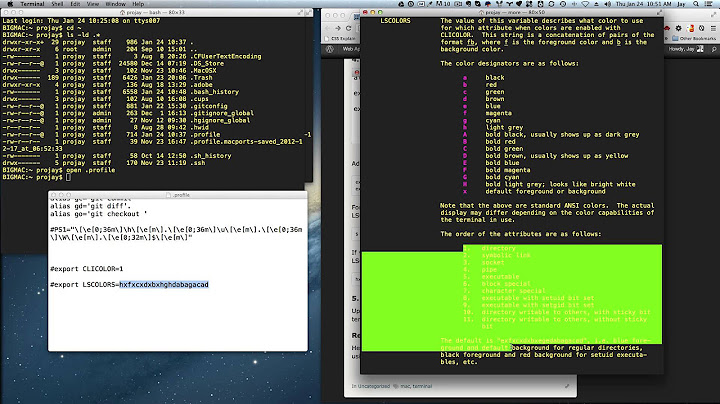How do I get ls --color=auto to work on Mac OS X?
Solution 1
ls is actually separate from Bash. Mac OS X has a BSD version of ls, which requires -G on the command line, or CLICOLOR (and perhaps LSCOLORS) in the environment.
See man ls for more info.
Solution 2
Open the terminal window and type:
alias ls='ls -G'
Then hit Enter and done!
Solution 3
Use Homebrew.
brew install coreutils
Note that this will throw a prefix of g in front of all the commands (e.g., gls for ls). It gives an option to source a file that will alias these for you automatically.
I wasn't sure if there was an option to install them directly without having to do the whole alias thing, so instead in installed MacPorts and did this.
Solution 4
compatibility for GNU and *BSD/darwin ls
~/.profile
#for *BSD/darwin
export CLICOLOR=1
ls --color=auto &> /dev/null && alias ls='ls --color=auto' ||
~/.bashrc (I don't remember if bash on Linux always reads ~/.profile, but not my zsh on ARCH)
[[ -f $HOME/.profile ]] && source $HOME/.profile
Solution 5
You'll need to install an alternate version of ls. The one usually used in linux is from the GNU coreutils project.
You could build and install or install from macports, fink or homebrew.
Related videos on Youtube
cfischer
Updated on September 17, 2022Comments
-
 cfischer almost 2 years
cfischer almost 2 yearsI'm trying to move my bash configuration from Ubuntu to Mac OS X and it looks like ls is slightly different. For instance, it won't accept the
--coloroption.How do I get this to work?
-
ayaz almost 14 yearsDitto. I've
alias ls='ls -G'set in my .bashrc on Snow Leopard. -
ayaz almost 14 yearsThat's overkill, in my opinion. You don't need to install a separate version of
lswhen the same feature is supported slightly differently on the existing version ofls. -
Doug Harris almost 14 yearsGood point. Then again, colored ls has never been my taste.
alias ls='ls -F' -
mipadi almost 14 years
alias ls='ls -FG'-- it's the best of both worlds! -
 senderle over 10 yearsI do this using homebrew. It's not overkill if you use both Mac and *nix computers and want your terminals to look the same -- this allows you to use the same config files across all computers. It's installed as
senderle over 10 yearsI do this using homebrew. It's not overkill if you use both Mac and *nix computers and want your terminals to look the same -- this allows you to use the same config files across all computers. It's installed asglsand doesn't replace the original so there's really no downside. -
bwDraco over 9 yearsCan you explain this code?
-
Victor Gavro over 9 yearssetting CLICOLOR environment variable for *BSD and Darwin systems - if it's set ls and possibly other utilities would work colored, but GNU ls (for Linux) ignores it. If "ls --color=auto" will not fail (exit status =0) - we have GNU version of ls and making alias to draw color codes in interactive mode, if it fails - then we don't need alias because of CLICOLOR variable. "&> /dev/null" just don't show stderr and stdout if something fail or if it's ok. Works for my linux and osx. (p.s. bash on osx and freebsd doesn't read .bashrc, so put it in .profile. already fixed it).
-
 z0r over 6 yearsThe output says: If you really need to use these commands with their normal names, you can... Why does it emphasise really? What are the downsides?
z0r over 6 yearsThe output says: If you really need to use these commands with their normal names, you can... Why does it emphasise really? What are the downsides? -
Dmitriy Korobskiy over 5 yearsFor some reason,
CLICOLOR=Ystopped working on my Mac.alias ls='ls -G'would forcelsto colorize. I define this for interactive terminals only. -
barlop over 5 yearsAnd you never archived your page on archive.org and now your link in your last paragraph is gone
-
 adfaklsdjf over 2 yearsI added that to my $PATH recently and I can't get the GNU ls to show color without explicitly doing
adfaklsdjf over 2 yearsI added that to my $PATH recently and I can't get the GNU ls to show color without explicitly doingls --color=auto..eval $(dircolors)set the LS_COLORS environment variable as expected but still no color without --color. ideas?




